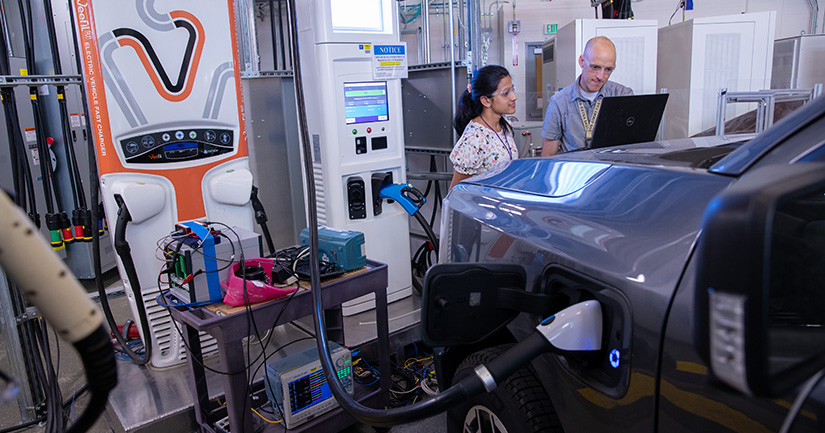Next-Generation Profiles Project Makes Electric Vehicle High-Power Charging Safer and More Reliable
Electric vehicles that use high-power charging are quickly becoming the new standard—understanding the grid impacts of high-power charging will ensure intergrid reliability and keep charging costs low.
High-power charging is quickly becoming the new standard for electric vehicles (EVs). At 200 kilowatts (kW) and above, high-power charging is expected to help drivers spend less time charging, get back on the road faster, and travel longer distances. Creating a widespread network of reliable and interoperable high-power charging stations, however, is still elusive, as the technology’s enormous power requirements are more complex than charging light-duty electric passenger vehicles at 40 kW to 50 kW and more dependent on battery conditions.
Enter the Next-Generation Profiles (NextGen Profiles) project, a signature project of the U.S. Department of Energy’s (DOE's) Electric Vehicles at Scale Consortium (EVs@Scale Lab Consortium) of national laboratories. Through the NextGen Profiles project, researchers are taking critical steps to assess EVs and electric vehicle supply equipment (EVSE) that are expected to utilize high-power charging. Importantly, this includes understanding how high-power charging systems respond to grid disturbances and smart-charge-management scenarios, as well as analyzing how electric fleets perform in those situations.
Funded through DOE’s Vehicle Technologies Office, NextGen Profiles is a collaborative EVs@Scale Lab Consortium project led by Argonne National Laboratory, with coprincipal investigators from Idaho National Laboratory, the National Renewable Energy Laboratory (NREL), and Oak Ridge National Laboratory. Original equipment manufacturers, industry stakeholders, and EV suppliers also partner with the four national laboratories to evaluate EV assets and refine validation procedures.
“The data that we’re collecting for NextGen Profiles addresses a lot of the challenges associated with vehicle electrification,” said NREL’s Keith Davidson, a lead principal investigator for the NextGen Profiles project. “Chief among those is charging reliability and keeping chargers operating consistently.”

Technical Approach Bakes in Planning, Integration, and Reliability Considerations
Paramount to a seamless EV charging experience is balancing safety, charging performance, and EV battery longevity. Within those requirements, the NextGen Profiles project helps identify high-power charging system limitations, the characteristics of high-power charging sessions (called “profiles”), and issues that the power grid will likely encounter.
“Ultimately, the project seeks to develop a knowledge base that will inform high-power charging infrastructure planning, integrate storage and renewables, and ensure that the transition to EVs is reliable and affordable,” Davidson said.
To achieve these goals, the NextGen Profiles project focuses on three key research areas. The first area captures EV profiles by collecting data on how EVs behave while charging. Researchers examine how diverse charging conditions affect EVs and how these profiles compare to different vehicle classes (e.g., medium- and heavy-duty vehicles) and charging types (e.g., conductive and wireless). Taken together, the data paints a holistic picture of the performance of current EV technologies and the trajectory of the industry.
The second area characterizes electric vehicle supply equipment (EVSE)—the equipment needed to charge EVs. This work involves connecting a high-power charging system to an EV emulator and running them through charging scenarios. One of the most important investigations encompasses an assessment of the entire range of current and voltage outputs that a charging system provides. The sum of these currents and voltages are not yet attainable by most vehicles, but the emulation capability has enabled researchers to achieve those levels, understand how the systems perform, and formulate strategies for systems to handle the high-power charging needs of the future.
Characterization of EVSE also incorporates grid disturbance analysis and charge management analysis. This has included researchers subjecting charging stations to repeated high-power charging cycles to illuminate thermal management needs based on how the EVSE recovers in between high-power charge sessions.
Off-Nominal Temperature Research Puts Charging Performance to the Test
At NREL, the NextGen Profiles team characterizes charging performance of EVs and EVSE currently available in the United States. Off-nominal temperature tests are a key component of this work, which involves subjecting vehicles to cold, nominal (23°C), and hot temperatures and subsequently charging, quantifying, and analyzing the amount of energy available in the batteries at specific points in time relative to their total capacity and age. Off-nominal grid conditions tests are also critical for EVSEs to measure and evaluate voltage, frequency, harmonics, thermal control systems, and standard charging communication protocol response.
“During a cold soak test, EV and EVSE charging characteristics are assessed when it meets our specific cold-temperature conditions,” Davidson shared. “We also run hot-weather tests in much the same way but are also exploring upgrading thermal chambers for this type of work as well.” Thermal chambers are enclosed temperature-adjustable spaces that enable comprehensive environmental validation activities indoors.

While opportune timing for weather-dependent tests is essential, other tests have more flexibility. During nominal-temperature evaluations, EVs and EVSE are assessed at room-temperature (23°C), which are attainable inside laboratories. The “predriven” test entails conditioning vehicles and their respective batteries by operating them for a fixed amount of time, then subjecting them to a series of charges and other tests that are not weather-specific.
Project Partnerships Provide Necessary EV Assets, Critical Perspectives
DOE’s national laboratories’ unique instruments, facilities, and connections to various suppliers and manufacturers are crucial to the success of NextGen Profiles. Participating laboratories in the project have access to a comprehensive array of charging stations, vehicles, EV emulators, grid emulators, wireless charging systems, and thermal chambers. The multidisciplinary NextGen Profiles research team leverages these resources to conduct cutting-edge research that advances the state of high-power charging and benefits project partners.
“For instance, sometimes we’re finding interoperability issues—such as procedures that some original equipment manufacturers might not have implemented consistently,” Davidson elaborated. “We may also find charging defects. In these cases, we send our findings back to the manufacturer, and they rolled out updates to fix these issues.”
The project team continues to seek collaborative partnerships to provide qualifying assets, such as vehicles, chargers, and hardware with the forthcoming SAE International J3400 charging standard, as they come to market. Project partners receive ongoing detailed data sets that provide critical perspective on how their EVs and EVSEs are performing in nominal and off-nominal conditions.
All high-level findings from the NextGen Profiles project thus far are published in a series of reports that provide data and insight for use by numerous entities including modeling and simulation organizations, policymakers, fleet planners, and industry stakeholders among others involved with the development and deployment of electrified transportation technologies. The NREL-authored report, High Level Analysis & Procedures: A NextGen Profiles Project Report summarizes the electrified mobility charging landscape, while NextGen Profiles testing procedures and findings are detailed in the other three project reports:
- EV Profile Capture: A NextGen Profiles Project Report details test data, outcomes, and evaluation related to EV charging profile capture.
- EVSE Characterization: A NextGen Profiles Project Report details test data, outcomes, and evaluation related to EVSE performance characterization.
- Fleet Utilization: A NextGen Profiles Project Report details insights from case studies of EV and EVSE fleet utilization.
Researchers plan to release additional high-power conductive and wireless charging results in future publications as part of the EVs@Scale Lab Consortium NextGen Profiles project.
Learn more about the U.S. Department of Energy’s Electric Vehicles at Scale Consortium and NREL’s electric vehicle grid integration capabilities. Sign up for NREL's quarterly transportation and mobility research newsletter, Sustainable Mobility Matters, to stay current on the latest news.

